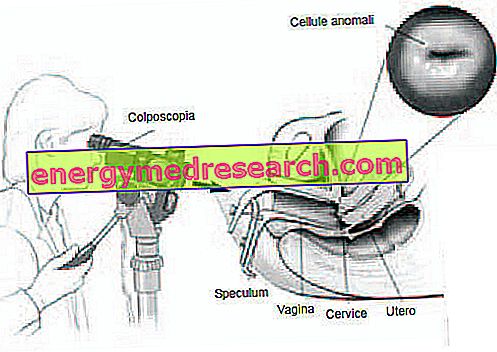Generality
The aortic valve, also known as the aortic lunate valve, is located in the orifice between the left ventricle of the heart and the mouth of the aorta. Its job is to regulate the flow of oxygenated blood to the various tissues and organs of the body.
Some references to the anatomy of the heart
Before proceeding with the description of the tricuspid valve, it is useful to recall some features of the organ in which it is found: the heart .
The heart is an unequal, hollow organ made up of involuntary striated muscle tissue. Its main function is to put blood into the vessels; it is therefore comparable to a pump, which, by contracting, pushes the blood towards the various tissues and organs. It has a shape reminiscent of an inverted pyramid. At birth, the heart weighs 20-21 grams and, in adulthood, reaches 250 grams in the woman, and 300 grams in the man. The heart resides in the chest, at the level of the anterior mediastinum, rests on the diaphragm and is slightly shifted to the left. It is enveloped by the pericardium, a serofibrosis sack, which has the task of protecting it and limiting its distensibility. The heart wall is formed by three overlapping habits that from the outside to the inside take the name of:
- Epicardium . It is the outermost layer, in direct contact with the serous pericardium. It consists of a superficial layer of mesothelial cells resting on the underlying layer of dense connective tissue, rich in elastic fibers.
- Myocardium . It is the middle layer, made up of muscle fibers. Myocardial cells are called myocardiocytes. Both the contraction of the heart and the thickness of the cardiac wall depend on it. It is necessary for the myocardium to be correctly sprayed and innervated, respectively by a vasal and a nervous network.
- Endocardium . It is the lining of the cardiac cavities (atria and ventricles), consisting of endothelial cells and elastic fibers. To separate it from the myocardium, there is a thin layer of loose connective tissue.
The internal conformation of the heart can be divided into two halves: a right and a left part. Each part consists of 2 cavities, or chambers, distinct, called atria and ventricles, within which the blood flows.
Atrium and ventricle of each half are placed one above the other, respectively. On the right side, there is the right atrium and the right ventricle ; on the left side, there is the left atrium and the left ventricle . To divide neatly the atria and the ventricles of the two halves, an interatrial and an interventricular septum are present, respectively. Although the blood flow in the right heart is separated from the left one, the two sides of the heart contract in a coordinated manner: first the atria contract, then the ventricles.
The atrium and ventricle of the same half are instead in communication with each other and the orifice, through which the blood flows, is controlled by an atrioventricular valve . The function of the atrioventricular valves is to prevent the reflux of blood from the ventricle towards the atrium ensuring the unidirectionality of the blood flow. The mitral valve belongs to the left half and controls the flow of blood from the left atrium to the left ventricle. The tricuspid valve, on the other hand, lies between the atrium and the ventricle on the right side of the heart.
In the ventricular cavities, both right and left, there are two other valves, called semi-lunar valves. In the left ventricle resides the aortic valve, which regulates blood flow in the left ventricle-aorta direction; in the right ventricle takes place the pulmonary valve, which controls the flow of blood in the direction right ventricle-pulmonary artery. Like atrioventricular valves, these too must ensure unidirectional blood flow.
The tributary vessels, that is, those that carry blood to the heart, "discharge" into the atria. For the left heart, the inflowing vessels are the pulmonary veins . For the right heart, the tributaries are the superior vena cava and the inferior vena cava .
The effluent vessels, that is, those that drain blood from the heart, depart from the ventricles and are precisely those controlled by the valves described above. For the left heart, the effluent vessel is the aorta . For the right heart, the effluent is the pulmonary artery .

The blood circulation, which sees the heart as the protagonist, is the following. At the right atrium, blood rich in carbon dioxide and low in oxygen, which has just sprayed the organs and tissues of the body, arrives through the hollow veins. From the atrium, blood reaches the right ventricle and enters the pulmonary artery. Through this pathway, blood flow reaches the lungs to oxygenate and release carbon dioxide. After this operation, the oxygenated blood returns to the heart, in the left atrium, via the pulmonary veins. From the left atrium it passes to the left ventricle, where it is pushed into the aorta, that is the main artery of the human body. Once in the aorta, blood goes to flush all the organs and tissues, exchanging oxygen with carbon dioxide. Depleted of oxygen, the blood takes the venous system to return to the heart, in the right atrium, to "recharge". And so a new cycle is repeated, the same as the previous one.
The movements performed by the blood take place following a phase of relaxation followed by a phase of contraction of the myocardium, ie the heart muscle. The relaxation phase is called diastole ; the contraction phase is called systole .
- During diastole:
- The cardiac musculature of atria and ventricles, both right and left, is relaxed.
- The atrioventricular valves are open.
- The semilunar valves of the ventricles are closed
- The blood flows, through the inflowing vessels, first into the atrium and then into the ventricle. The transfer of blood does not occur in its entirety, as a portion remains in the atrium.
- During the systole:
- Cardiac muscle contraction occurs. The atriums begin, followed by the ventricles. We speak, more precisely, of atrial systole and ventricular systole:
- The amount of blood left in the atria is pushed into the ventricles.
- Atrioventricular valves close, preventing blood reflux in the atria.
- The semi-lunar valves open and the ventricular muscles contract.
- The blood is pushed into the respective effluent vessels: pulmonary veins (right heart), if it has to oxygenate itself; aorta (left heart), if it is to reach tissues and organs.
- The semi-lunar valves close after the blood has passed through them.
Diastole and systole alternate during blood circulation and the behavior of cardiac structures, regardless of whether the blood is in the right half or the left half of the heart, are the same.
To complete this overview of the heart, two other important topics remain to be mentioned. The first concerns the how and where the myocardial contraction nerve signal is born. The second concerns the vascular system that irrigates the heart.
The nervous impulse that generates the contraction of the heart is born in the heart itself. In fact, the myocardium is a particular muscle tissue, endowed with the capacity to self - control . In other words, myocardiocytes are able to generate the nervous impulse for contraction by themselves. The other striated muscles present in the human body, on the other hand, need a signal from the brain to contract. If the nerve network leading to this signal is interrupted, these muscles do not move. The heart, on the other hand, has a natural cardiac pacemaker, known as the atrial sinus node ( SA node ), at the junction of the superior vena cava and the right atrium. Generally, we talk about a pacemaker referring to artificial devices, capable of stimulating the contraction of the heart of patients suffering from certain cardiopathies. To correctly conduct the nerve impulse, born in the SA node, to the ventricles, the myocardium has other pivotal points: in succession, the signal generated by it passes through the atrioventricular node ( AV node ), for the His bundle, and for the Purkinje fibers .
The oxygenation of cardiac cells is the responsibility of the coronary arteries, right and left. They originate from the ascending aorta. Their malfunction results in ischemic heart disease. Ischemia is a pathological condition characterized by the lack or insufficient blood supply to a tissue. The blood, once the oxygen has been exchanged with the cardiac tissues, takes the venous system of the cardiac veins and coronary sinus, thus returning to the right atrium. The entire vascular network of the heart resides on the surface of the myocardium, in order to avoid their constriction at the time of cardiac muscle contraction; situation, the latter, which would alter the blood flow.
Function and anatomy of the aortic valve
The aortic or semi-lunar aortic valve is located in the orifice that connects the left ventricle of the heart and the aorta . It plays a fundamental role: it regulates the flow of oxygenated blood coming from the heart towards organs and tissues, guaranteeing their unidirectionality . At the time of the ventricular systole, in fact, the aortic valve is open and allows the passage of blood into the aorta. When the passage is completed, the valve closes preventing reflux. The opening and closing mechanism depends on the pressure gradient, that is on the difference in pressure existing between the ventricular compartment and the aorta. Indeed:
- When in the left ventricle the pressure is greater than in the aorta, the valve opens, favoring blood efflux. The increase in intra-ventricular pressure depends on the ventricular systolic contraction.
- When the ventricular systolic contraction is exhausted and the blood has flowed into the aorta, the pressure in the aorta is higher than that of the ventricle. This causes the aortic valve to close.
The aortic valve is composed of the following anatomical elements:
- The orifice is delimited by the valve ring . The surface of the orifice measures, in the adult, a value between 2.5 and 3.5 cm2; its diameter, instead, measures 20 mm.
- It is tricuspid, that is it has three flaps (or cusps) of semi-lunar form. The cusps are arranged, on the valve ring, in a staggered manner, such as to prevent the reflux of blood, once the valve is closed. The flaps consist of loose connective tissue, rich in collagen and elastic fibers. As with the other heart valves, the cuspid tissue does not present vascularization, nor does it have a nervous or muscular control.
diseases
The most common aortic valve disorders are:
- Aortic stenosis . This is a narrowing of the valve orifice, caused by the fusion or stiffening of the cusps.
- Aortic insufficiency . This is an incomplete closure of the aortic orifice during the ventricular systole. The blood therefore returns from the aorta to the left ventricle. The responsible lesion, which compromises the function of the aortic valve, can occur at the level of the cusps, of the valve ring or of the walls of the aorta closest to the valve structure.
Sometimes, these two diseases can occur simultaneously.



